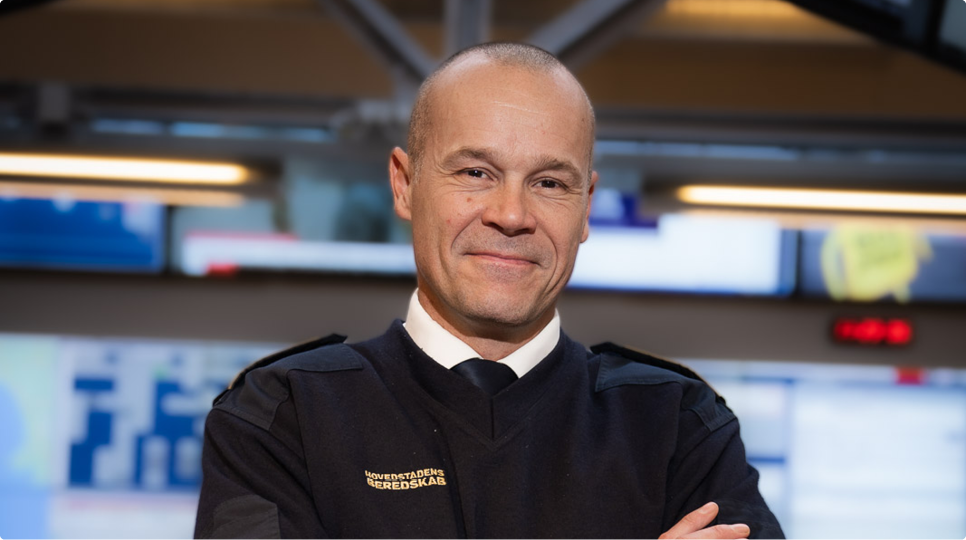More than 10 years of live streaming experience: Interview with Fredrik Ryber, Head of Operations at the Greater Copenhagen Fire Department
For more than 10 years the Greater Copenhagen Fire Department has used visual communication including live streaming, when responding to fire and rescue incidents in the Capital Region of Denmark.

Video have become an important tool in the daily work and today the Fire Department has around 20 camera sources, including cameras on all fire engines, which are controlled from the command centre. In addition, they have drones, thermal cameras, night vision cameras and cameras installed on all incident command vehicles.
We spoke to Fredrik Ryber, Head of Operations at the Greater Copenhagen Fire Department, about how livestreaming is used, what benefits and challenges he sees in it, and his recommendations to other organisations who are about to start using visual communication.
You’ve been using live streaming for more than 10 years, can you tell us a bit about where you are today?
Yes, we’ve done a lot of work with live streaming over the past 10 years, but that doesn’t mean I think we’re finished learning and exploring. We’re constantly trying to tweak the way we use it and the tools we use, so that we continuously improve and fill in any gaps we find. It also means that we now have a very good foundation for managing and operationalising information in connection with our efforts – and that we are always ready to take new steps.
How do you work with Bliksund?
All our visual communication solutions are developed in collaboration with Bliksund, and together with Bliksund we are continuously developing ways to form and improve our overview. We have a common platform where we have gathered all of our streaming sources, so that we can see and evaluate how we view the different incidents.
Could you tell us a bit more about the stage you’re at now?
There’s a lot of information in connection with our operations, and today we are at the point where we have learned to channel the information, so that the right people get the right information at the right time. This is quite crucial in connection with information overload, for example.
With all these digital tools at our disposal, it’s important that we pay close attention to how we use them – we shouldn’t just use them for the sake of using them, we should use them when it improves our work. It’s a question of balance, in which we are constantly learning more as we use the tools in our work. It’s an art form to adapt the amount of information so that we don’t put our incident managers or our people in the field under unnecessary pressure, but give them the information when they can operationalise it.

What do you do to avoid information overload?
It’s really an interface between technology and people, so it’s important that we have a dialogue about when it makes sense for the individual to use the communication tools we have. It’s important that there is a dialogue between internal and external management – between those who are back in the command or operations centre and those out in the field at the scene of an incident.
When you receive an emergency call, how do you use visual communication in the command centre?
If a private individual makes an emergency call, we have the ability to take over the camera in the caller’s smartphone using IncidentShare. That way, we can see what the person is trying to explain to us. Having the picture as a supplement helps us to see things in a more nuanced light, which means we can prepare those who are on their way out so they have the right mindset. At the command centre, we’re trained to interview the caller and ask questions, but being able to get a picture means that we can prepare and act faster when we get to the site. We can customise the response and upgrade or downgrade the resources, and thereby supplement or adapt to the need.
Have you experienced any challenges with visual communication?
You have to match the amount of information to what you can handle. As an incident commander at an accident site, you can be under a lot of pressure, and in such a situation, the support staff shouldn’t provide a lot of information. As an operations centre, we need for example to adapt the information to when it is most useful, and make sure it doesn’t become a burden. If it just leads to information overload, it’s not doing any good. It takes a little training to know who should receive the information, and when.
What future possibilities do you see with visual communication for the Greater Copenhagen Fire Department?
If you look at our operations as a timeline, we’re pretty well covered when it comes to camera coverage. However, we are naturally concerned with any blind spots. There are some periods when we’re a little bit blind. This might for example be the phase before we arrive at the scene of an incident. In this context, we are working on a project with autonomous drones that can fly off in response to a call. If we can improve our presence before we arrive at the scene, then we can get a good handle on it.
We’ve come so far now that we can start to fine tune. We’re working with several streaming methods, and we’re in the development phase where we can see the really big advantages.
What recommendations would you give to organisations that are just starting out with visual communication?
You shouldn’t be afraid to get started. Once you’re up and running and trying things out, you can start to customise and see what works. You have to go into it with an open mind. You can’t just throw new technology into an organisation, you have to look at your circumstances and needs, the staff and resources you have, and then adapt the technology to that. It’s only then that can you see how it could make a difference to your resources and organisation.
If you want to start using IncidentShare or if you have questions about how live video can contribute to your workplace, please contact us here.


